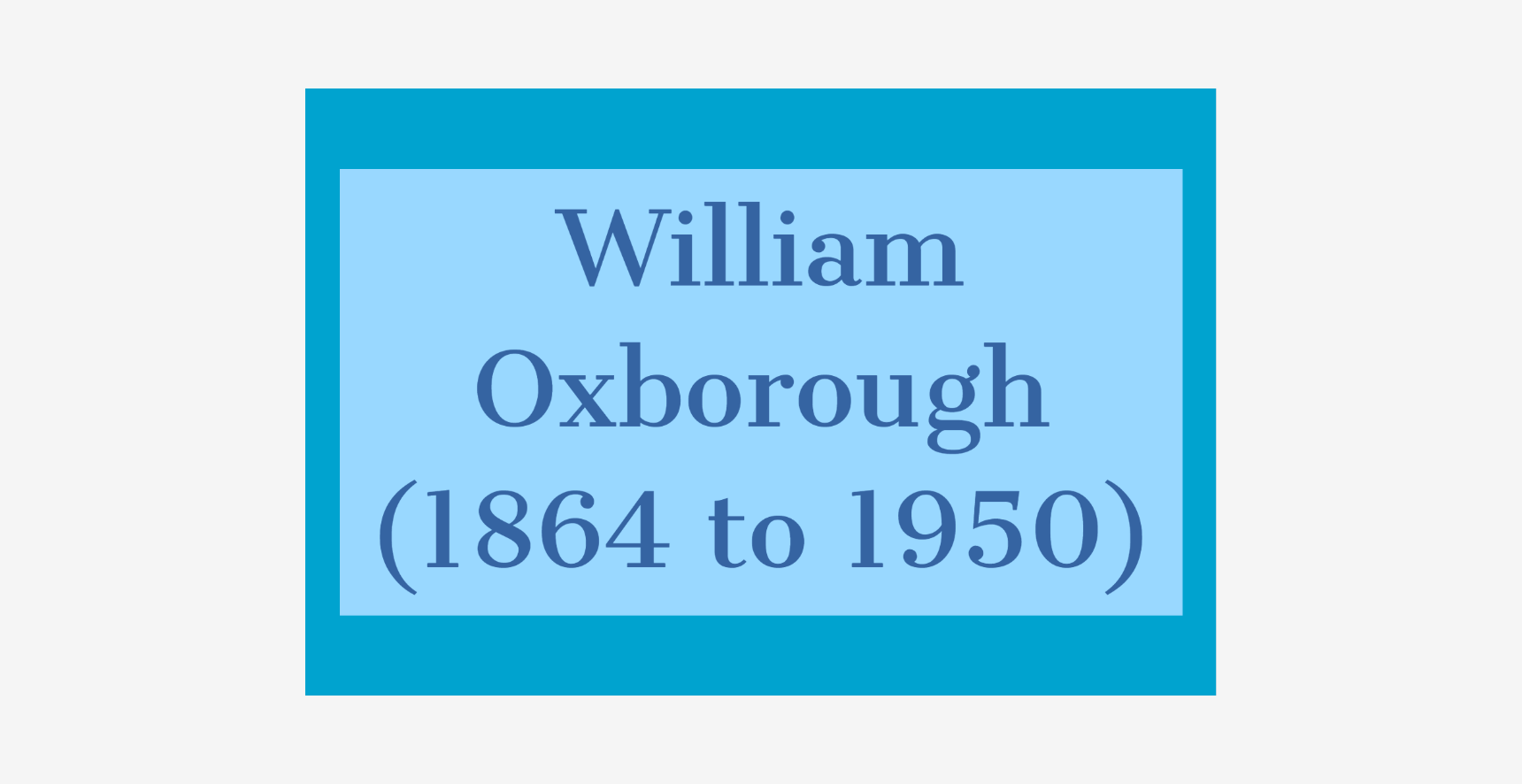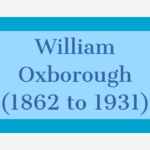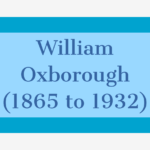Emma and Charles did not have a happy marriage. Emma may have suffered from depression caused by childbirth, alcoholism, or mental abuse. She spent her last 3 1/2 years in a lunatic asylum called St Audry’s Hospital.
William Oxborough
Born: 26 NOV 1864 in Beccles, Suffolk County, England
Father: unknown
Mother: Elizabeth Ann Oxborough (1846 to 1875)
Spouse: Harriet Louisa Barber (1865 to 1954)
Married: 1885 in Beccles, Suffolk County, England
Children:
Annie Elizabeth Oxborough (20 OCT 1885 to 25 DEC 1965)
William Charles Oxborough (2 JAN 1889 to 12 APR 1952)
Florence Elsie Oxborough (5 JUN 1890 to 1973)
James Ernest Oxborough (1893 to 12 APR 1918)
Lilian Oxborough (30 JUN 1895 to 1973)
Died: 1 APR 1950 in Beccles, Suffolk County, England
Burial: Beccles Cemetery
Timeline:
1871 Beccles, Suffolk County, England
1875 Death of mother, Elizabeth
1881 Beccles, Suffolk County, England
1885 Marriage to Harriet
1885 Birth of daughter, Annie
1889 Birth of son, William
1890 Birth of daughter, Florence
1891 Beccles, Suffolk County, England
1893 Birth of son, James
1895 Birth of daughter, Lilian
1901 Beccles, Suffolk County, England
1911 Beccles, Suffolk County, England
1918 Death of son, James
1939 Beccles, Suffolk County, England
1950 Death and Burial
Occupation: bricklayer
Records:
1871 to 1911 England Census Records
1939 England and Wales Register
England & Wales, FreeBMD Birth Index, 1837-1915
England & Wales, FreeBMD Marriage Index: 1837-1915
England & Wales, Death Index: 1916-2005
UK and Ireland, Find A Grave Index, 1300s-Current
Variations of Surname: None
Daughters:
Annie Elizabeth Oxborough:
Annie was born on 20 OCT 1885 in Beccles, Suffolk County, England. She died on 25 DEC 1965 in Beccles, Suffolk County, England.
Annie married Frederick Charles Gould in 1904 in Beccles, Suffolk County, England. Eight known children were born to this marriage:
Ethel May Gould (1904)
Florence Rose Gould (1906)
Annie Elizabeth Gould (1909)
Alice Lilian Gould (1913)
Phyllis Gould (1916)
Hilda Gould (1922)
Faith Gould (1924)
Arthur Frederick Gould (1929)
Frederick Charles Gould was born on 8 NOV 1884 in Beccles, Suffolk County, England. He died on 2 FEB 1940 in Beccles, Suffolk County, England.
Florence Elsie Oxborough:
Florence was born on 5 JUN 1890 in Beccles, Suffolk County, England. She died in 1973 in Saxmundham, Suffolk County, England.
Florence married George Isaac Gissing on 30 SEP 1911 in Beccles, Suffolk County, England. One known child was born to this marriage:
Lilian Doris May Gissing (1914 Billericay, Essex)
George Isaac Gissing was born on 22 OCT 1886 in Kesale, Suffolk County, England. He died in 1970 in Samford, Suffolk County, England.
Samford was a registration district in Suffolk County, England between 1837 and 1974. There were 48 civil parishes in Samford at that time. I do not know which parish George was living in at the time of his death.
Lilian Oxborough:
Lily was born on 30 JUN 1895 in Beccles, Suffolk County, England. She died in 1973 in Norwich, Norfolk County, England.
Lily married Bertie William Pearl in 1920 in Beccles, Suffolk County, England. Four known children were born to this marriage:
Queenie I Pearl (1920)
William C Pearl (1922)
Victor W Pearl (1927)
Violet D Pearl (1932)
Bertie William Pearl was born on 17 MAY 1896 in Felixstowe, Suffolk County, England. He died in 1946 in Beccles, Suffolk County, England.
Spouse:
Harriet Louisa Barber:
Harriet was born on 19 JUL 1865 in Beccles, Suffolk County, England. She died on 20 JUN 1954 in Beccles, Suffolk County, England.
Probate:

Harriet was born out of wedlock to Emma Barber.
Emma Barber was born in 1842 in Beccles, Suffolk County, England. She died on 6 FEB 1894 in Melton, Suffolk County, England.
Emma married Charles Beales on 31 DEC 1866 in Beccles, Suffolk County, England. Six known children were born to this marriage:
Charles William Beales (1867)
James Beales (1873)
William Beales (1877)
Alice May Beales (1879)
Ellen Maria Beales (1883)
Elizabeth Patience Beales (1887)
A Little History:
In 1868, Emma was 26 years old when she gave birth to her first child, Charles.
In 1873, Emma was 31 years old when she gave birth to her second child, James.
On 9 SEP 1874, Emma was admitted into St Audry’s Hospital in Melton, Suffolk County, England. She spent 8 1/2 months in this facility before being released on 16 APR 1875.

On 23 MAY 1876, Charles appeared in court for not sending his two oldest children to school. The article appeared in the East Suffolk Gazette and can be found on the Foxearth website.

In 1877, Emma was 35 years old when she gave birth to her third child, William.
In 1879, Emma was 37 years old when she gave birth to her fourth child, Alice. Alice was born in Shipmeadow, Suffolk County, England. The Wangford Union Workhouse was located in this parish.
The 1881 England census shows that Emma and four of her children were living with relatives at 66 Puddingmoor in Beccles. Her daughter, Harriet, was listed as the niece of James and Hannah Callow.

The 1881 England census shows that Charles was living with his brother, William, at 133 Ravensmere in Beccles. Charles was living less than a mile from his wife.

On 14 MAY 1882, Charles was charged with neglecting to support his wife and children. He was sentenced to 3 months of hard labor and sent to the Ipswich County Jail.

In 1883, Emma was 41 when she gave birth to her fifth child, Ellen.
in 1886, Emma was 44 when she gave birth to her sixth child, Eliza.
On 6 SEP 1890, Emma was admitted into St Audry’s Hospital in Melton, Suffolk County, England. She spent 3 1/2 years in this facility until she died on 6 FEB 1894.

My Thoughts:
St Audrey’s Hospital was a lunatic asylum that dealt with people with mental illnesses. Wikipedia has an article entitled Women in Psychiatric Institutions that caught my attention:
“Between the years of 1850 to 1900, women were placed in mental institutions for behaving in ways the male society did not agree with. These men had the last say when it came to the mental health of these women. . .”
Was this why Emma was sent to St Audry’s in 1874? Was she an independent thinker? As shown in the 1876 newspaper article, Emma had her own strong opinion about what school their children should attend.
I do not believe Emma and Charles had a happy marriage. In fact, it may have been an “on-again, off-again” type of relationship. They may have argued and fought. Violence may have led to these separations.
Their daughter, Alice, was probably born at the Union Workhouse in Shipmeadow. This would indicate that Emma had left Charles in 1879.
The 1881 England census showed that they were living in separate residences. The 1882 newspaper article confirms that Emma was not living with Charles.
Five of the six children were born at least 4 years apart. This could be an indication that Emma was not happy with her married life. That led me to another thought:
Could Emma have suffered from depression?
Emma was in her early forties when she gave birth to their two youngest children.
In 1890, Emma was 48 years old and taking care of at least four young children. They ranged in ages from 3 to 13 years old.
Depression is a mental health disorder. Some of the causes include childbirth, mental abuse, alcoholism, and, certain infectious diseases.
Depression is also one of the symptoms of dementia. Here is an excerpt from Wikipedia:
“Psychological symptoms can include depression, psychotic hallucinations and delusions, apathy, and anxiety.”
Could Emma have suffered from the early stages of dementia? Could her depression have led to suicidal thoughts?
This may be why Emma was sent to St Audry’s in 1890 and was not released.
Are you a descendant of Emma Barber and Charles Beales? Do you know what caused Emma to be institutionalized? If so, please contact me. My email is dlwakenight@yahoo.com. You can also leave a message in the Comments Section of this post.
Notes:
The surname, Oxborough, originated in Norfolk County, England. It appears in church registers as early as the mid-16th century. As the world population grew, these Oxborough ancestors moved to other counties in England. By the late 19th century, some had immigrated to Canada and Australia.
Creating Your Family Tree
Interested in building a great family tree? Remember these important steps:
Look in your photo albums. You may have old pictures that your parents or grandparents gave you. Or, ask them for copies of photos that they have in their possession. Many people will write names and dates on the backs of photographs. Letters, diaries, and family bibles are also excellent sources for births, marriages, and deaths.
Talk to your older relatives to find out about your ancestry. They may relate stories about an ancestor that you can add to your family tree. Family history is usually not found in newspapers. It is more of a verbal memory that is passed down from generation to generation.
Find the right family tree builder that suits your needs. You can choose one that has a paid subscription like Ancestry.com. There are also free sites like FamilySearch.org.
When you start building your family tree, add documentation to your ancestor’s profile. The records can include birth, marriage, death, census, military, city, and county directory listings. Any information that you can find will help create a life story about your ancestor.
If you have a unique surname, like Wakenight, you may find databases on the internet that are useful in your search. I use SurnameDB.com for my English surnames. There are many others on the internet for other countries like Ireland, Italy, and Germany.
Genealogy is the study of a person’s “line of descent.” As you create your family tree, you would typically start with one individual and go “back into time.” You would add their parents, grandparents, and so on. There are also family trees that go “forward into time.” Many of these family trees start with a famous person, such as a president or royalty, and move forward into the present time. The purpose of this type of pedigree is to establish a person’s bloodline with that famous person.
There is no limit on how big your family tree can grow. The blank canvas is there for you to use. Cherish your family history, and it will be there for generations to come!



Leave a Reply